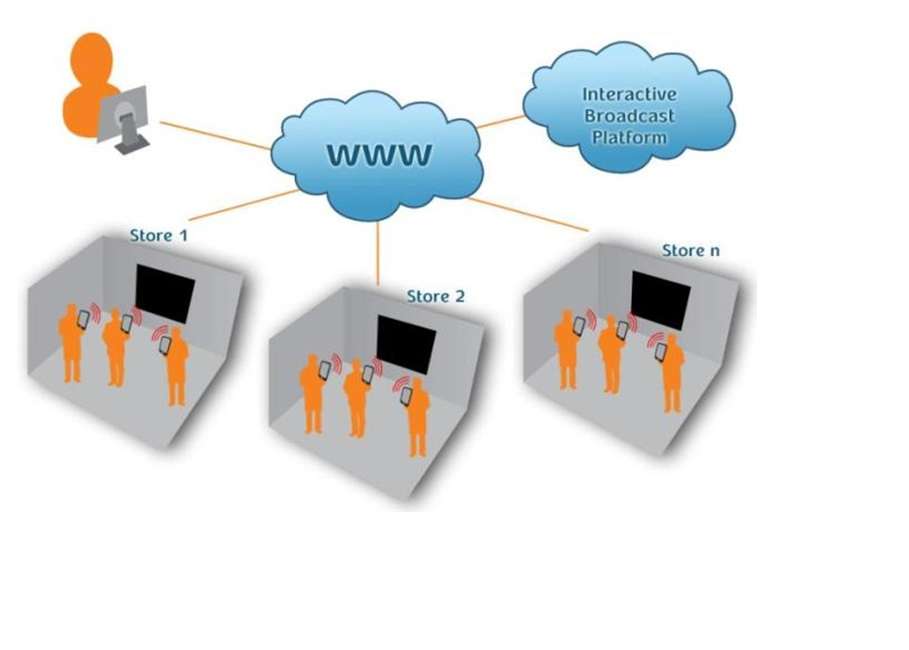Screen–smart device interaction
Screen-Smart Device Interaction (SSI) is fairly new technology developed as a sub-branch of Digital Signage.
Screen-Smart device Interaction is a set of mobile, networking, signal processing, software and hardware technologies that allows users with mobile devices (typically cellphones) to connect (using QR, URL or any other novel method) to a public screen and interact, control or acquire its content for emerging applications like effective outdoor advertising, event information distributions, out-of-home gaming, etc.[1] These technologies lets users in any venue use smart mobile devices to answer a poll/survey/quiz, win coupons and even participate in a game.
It differs from the Second screen configuration. The latter typically has the first screen being a big screen and the second screen being the smaller screen of a cellphone. Where the small screen cannot affect or control the big screen. The small screen is often used to provide supplementary data on the content of the big screen. In contrast, SSI is distinguished by the small screen being able to change the flow of information or content on the big screen.
The big screen shows an identifier of its computer network address. Often, the network is the Internet. The identifier might be in a barcode that is part of the image on the big screen. The mobile device scans the barcode, decodes it and queries a server. The server controls the big screen. When the server gets the query, it extracts the identifier of the big screen. The server can alter the mobile device screen and the big screen in a feedback loop.
The user of the mobile device can pick buttons in its web page to change the big screen. The mobile device functions as a remote control. The advantage is the decoupling of specific hardware requirements for the pair of the mobile device and the big screen. If the mobile device is a cellphone, it only needs a camera and wireless Internet access.
If the big screen shows a browser, then there are paired web pages. One for the small screen, one for the big screen. Microsoft calls this the "Companion Web". In general, the pages in the pair are different. The page for the big screen is essentially a digital poster. It does not need any buttons or selectable links. It can have large graphics. The large screen can be assumed to be on a wired connection, giving it large bandwidth. The small screen page is optimised for low bandwidth across a wireless connection.
SSI is gradually becoming a standard for Digital Signage Implementation, seeking to expand the traditional capabilities of this technology, adopting the modern Internet and 'Connected Devices' concepts. It is related to augmented reality and the Internet of Things.
Interactive Digital Signage might be a growth engine for traditional digital signage. Interactive capabilities are gaining increasing attention by retailers, clinics, hotels/restaurants/bars, and other venues that provide service to a 'captive audience'.
Muzzley is a trend in present technology that lets a user in any connected network access the Digital Signage screen using the smartphone. In this scenario, the smartphone keeps adapting its interface according to the experience that the user is having. Muzzley integrates with all the major digital signage manufacturers as well as traditional applications made in standard developing languages as javascript, java, node.js, flash / Action Script and others.
This Image is a schematic description of SSI implementation:

[2] [3] [4] [5] [6] [7] [8] [9] [10]
[11] [12] [13] [14] [15] r [16] [17] [18] [19] [20] [21] [22] [23] [24] [25]
References
- ↑ "Convergence of Interactive Displays with Smart Mobile Devices for Effective Advertising: A survey", J. She, J. Crowcroft, H. Fu, F. Li, ACM Transactions on Multimedia Computing, Communications, and Applications (TOMCCAP) TOMCCAP Volume 10, Issue 2, February 2014.
- ↑ NoviSign - "Digital Signage Gaming"
- ↑ Cayin - "Control digital signage"
- ↑ Comqi - "Passport links mobile phones to an in-venue digital screen"
- ↑ Crowdpurr - "Why should digital signage ... remain static when they can incorporate their audience in real-time?"
- ↑ Enteractv - "prospects use their cellphone to control a display screen inside the window"
- ↑ Kik - "turn your phone into a remote control for any screen with a browser"
- ↑ Locbit - "turn internet connected devices into a mouse and allow you to turn any surface into a digital canvas"
- ↑ Microsoft - "lays out vision to link big and small screens" and "companion web"
- ↑ Muzzley - "Control a wide range of devices with customizable interfaces using only your phone"
- ↑ Noisestreet - "turns any screen into a 2-way interactive experience"
- ↑ Novisign - "This four-in-a-row game is presented on a digital signage big screen"
- ↑ Scala - "QR code demo"
- ↑ - Cyber-physical Dragging Technologies"-
- ↑ http://cyphymedia.com/images/MusicVideo.mp4 CyPhy Media - "Collect Media With A Drag demos"
- ↑ Dimedis - "use the QR-Codes on the screen to directly control contents on the display"
- ↑ - "Short video on Digital Signage Gaming"
- ↑ Game Concourse - communicating and interacting with a display screen using a remote device
- ↑ Heeddooh -scan the QR code with their smartphones, and that will lead them to a website that acts as a remote control
- ↑ Media Signage - scans the QR code, his mobile device will... control your designated digital Signage screen
- ↑ Movilok - link temporarily the mobile phone with this interactive showcase
- ↑ Qr-screen - Interactive Narrowcasting with QR-codes
- ↑ Red Crystal - an interactive ‘session’ between your smart device and the screen on which you want to interact
- ↑ Smoothboard Air -
- ↑ Green Valley Media - scans the QR code, his mobile device will open an HTML page that will ... control your designated digital Signage